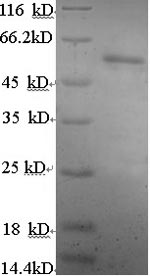Recombinant Human Estrogen receptor beta (ESR2) comes from yeast expression and includes an N-terminal 6xHis-tag that makes purification and detection much simpler. The protein covers amino acids 2 to 530, which represents a partial but substantial portion of the complete sequence. Purity levels exceed 90% based on SDS-PAGE analysis, though this should provide reliable performance in most downstream work.
Estrogen receptor beta (ERβ) belongs to the nuclear receptor family of intracellular receptors. This protein appears to play an essential role in how estrogens work throughout the body, affecting both gene expression and how cells function. ERβ seems to be involved in reproductive health, cardiovascular processes, and bone maintenance - areas that make it particularly interesting for researchers studying hormone signaling networks.
Potential Applications
Note: The applications listed below are based on what we know about this protein's biological functions, published research, and experience from experts in the field. However, we haven't fully tested all of these applications ourselves yet. We'd recommend running some preliminary tests first to make sure they work for your specific research goals.
Human ESR2 is a nuclear receptor that requires precise folding, dimerization, and ligand-binding domain formation for its transcriptional activity. The yeast expression system provides a eukaryotic environment that supports proper folding and some post-translational modifications, increasing the probability of correct folding compared to bacterial systems. However, the partial sequence (2-530aa) lacks the full N-terminal domain, and the protein may not achieve complete functional activity without proper ligand-binding capability. While yeast expression improves folding probability, experimental validation remains essential to confirm functional status.
1. Protein-Protein Interaction Studies Using His-Tag Pull-Down Assays
This application's reliability depends entirely on proper folding validation. Nuclear receptor interactions require precise tertiary structure for specific co-regulator binding. If correctly folded (verified), the protein is suitable for identifying physiological interaction partners like co-activators or co-repressors. If misfolded/unverified, the risk of non-specific binding or interaction failure makes results biologically misleading.
2. Antibody Development and Validation
Antibody development primarily relies on antigenic sequence recognition rather than functional folding. If correctly folded (verified), the protein excels for generating conformation-sensitive antibodies that recognize native ESR2 epitopes. If misfolded/unverified, it remains suitable for producing antibodies against linear epitopes, though these may not efficiently detect the native receptor structure.
3. Biochemical Characterization and Stability Studies
These studies are essential for determining folding status and biophysical properties. If correctly folded (verified), characterization provides insights into receptor stability and oligomerization behavior. If misfolded/unverified, analysis still yields valuable physical property data for this specific protein preparation.
4. Competitive Binding Assays and Ligand Screening
Functional binding studies require native receptor conformation. If correctly folded (verified), the protein enables valid ligand screening and binding affinity measurements. If misfolded/unverified, binding assays will yield misleading results and are not recommended for compound screening.
Final Recommendation & Action Plan
The yeast expression system provides a better eukaryotic environment for this nuclear receptor, but experimental validation is essential before functional applications. Begin with Application 3 (Biochemical Characterization) to assess folding quality through size-exclusion chromatography, circular dichroism spectroscopy, and thermal stability assays. If correct folding is verified, proceed to validate ligand-binding functionality using known ESR2 ligands. Once folding and function are confirmed, proceed confidently with Applications 1, 2 (conformational antibodies), and 4 for interaction studies, antibody development, and ligand screening. If misfolding is detected, limit applications to linear epitope antibody production (Application 2) and basic biophysical characterization, avoiding all functional interaction and binding studies. For reliable nuclear receptor research, always include appropriate controls and consider using full-length protein for complete functional characterization.






